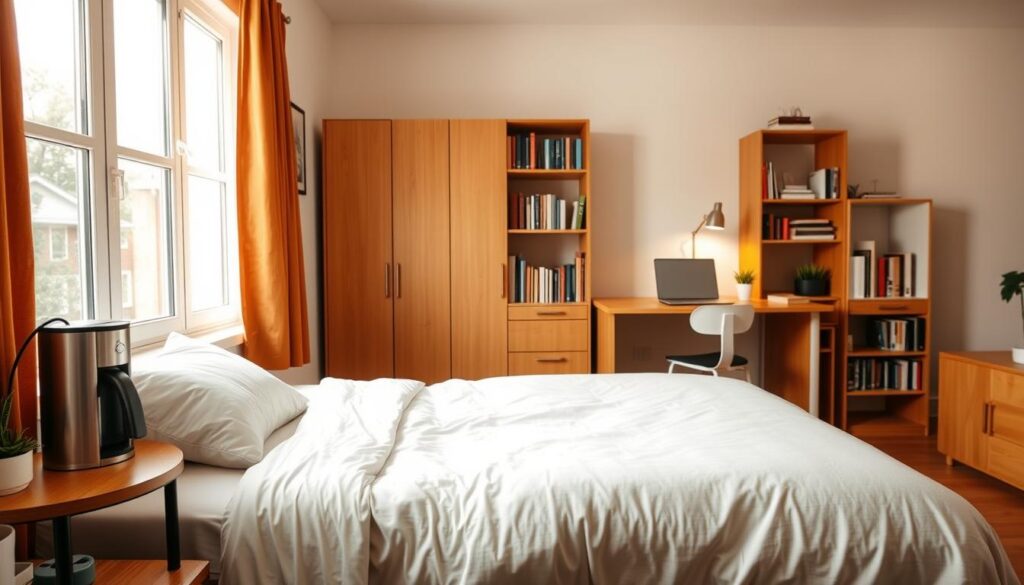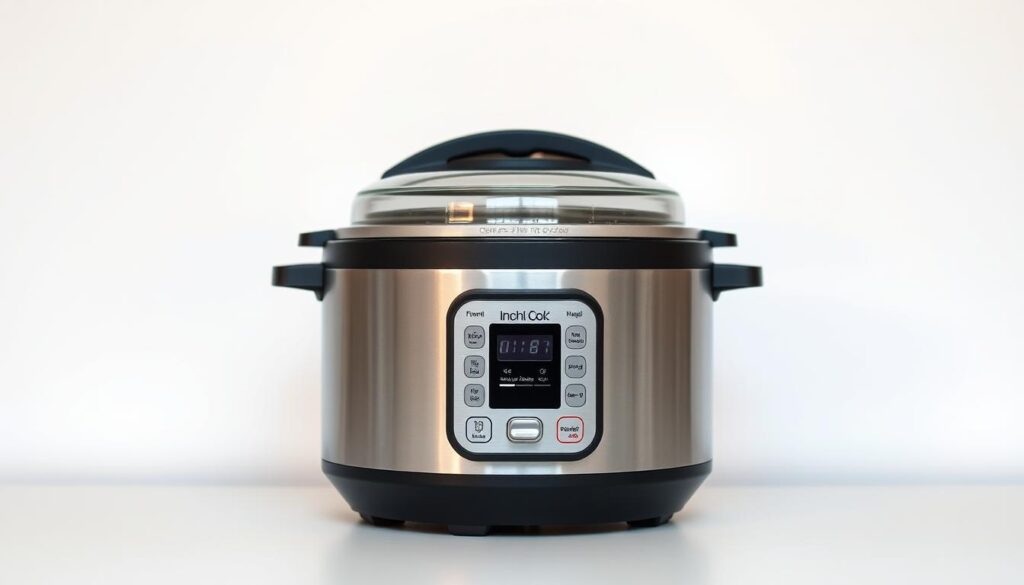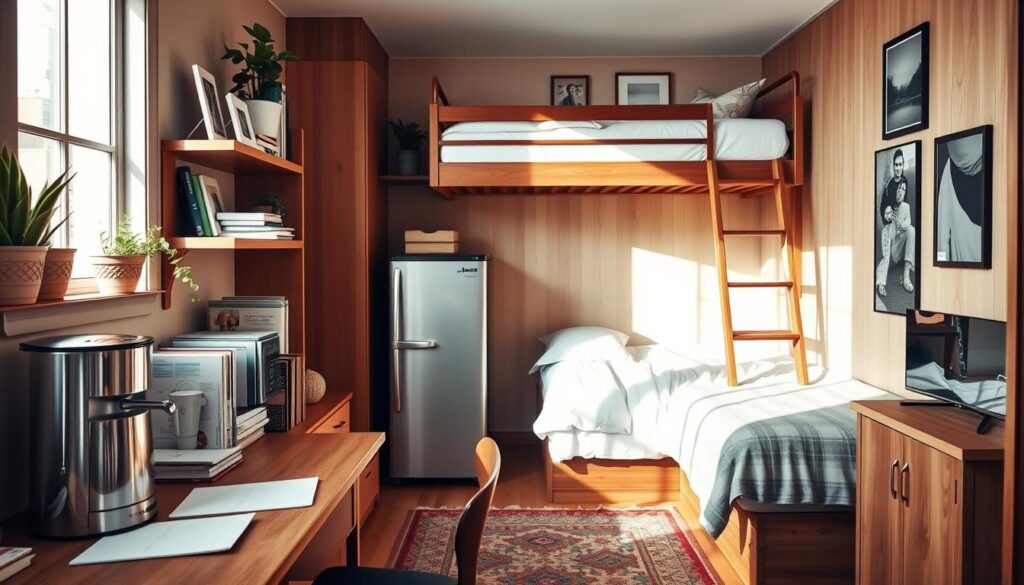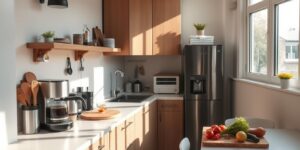Best Small Appliances for Student Apartments (That Actually Save Space)
Explore our curated list of the best small appliances for dorms, designed to fit compact spaces and meet student needs.
The article opens with a concise roundup aimed at students who need gear that fits tight quarters. It highlights compact, efficient picks that respect campus rules and wattage limits. Choices focus on quick prep, easy cleanup, and real space savings.

Many students skip dining halls and equip a dorm room with items like a 3.2-cu-ft Frigidaire mini fridge, a 700–900W compact microwave, a 1L Zwilling kettle with auto shut-off, and a Keurig K-Mini. Brands such as NutriBullet, Midea, Black & Decker, and Instant Pot appear often in college lists.
Campus rules often ban exposed heating elements, so they must verify housing policies before buying. MicroFridge rentals and provided units reduce duplicate purchases with roommates. This section previews a targeted list of essentials designed to build the perfect dorm room without wasting space.
Key Takeaways
- Prioritize compact, energy-rated gear that fits a tight room.
- Verify wattage and banned items in housing policies.
- Choose proven brands that students trust for durability.
- Consider campus rentals to avoid duplicate purchases.
- Pick items that speed prep and make cleanup easy.
What students actually need right now: space-saving dorm room essentials
Most college residents quickly learn that fewer, smarter purchases save space and time during the week.
Bring two to three core items that match real habits. Pick a mini fridge, a compact microwave, or a single-serve coffee maker if those meet morning and late-night needs.
Late-night snacks are common after dining halls close, so prioritize gear that handles quick food prep. Coordinate with a roommate to split cost and share square footage. Use rolling carts and over-the-door organizers to keep essentials reachable without cluttering the room.
What Else Would You Like to Know?
Choose below:
- Shop early for top-rated models to avoid stock shortages and price spikes.
- Choose energy-efficient units with auto shut-off and quiet modes for safer, calmer living.
- Add simple tools like microwave pasta cookers or soup mugs to stretch functionality.
| dorm room essentials | Why it helps | When to buy |
|---|---|---|
| Mini fridge | Keeps snacks and meal preps cold; reduces late-night runs | Early spring to avoid sell-outs |
| Compact microwave | Fast food reheating and quick meals during study sessions | Late spring before dorm move-in |
| Single-serve brewer | Saves time in mornings and cuts waste | Buy when prices drop in college sales |
Before you buy: dorm rules, wattage limits, and roommate planning
Before purchasing any gear, students should read their housing policies. A quick check saves money and avoids seized items at move-in.
Check allowed items and power limits
Every school sets specific rules about what may be used in a shared room. Many campuses ban exposed heating elements and list toasters, hot plates, and similar devices as prohibited.
- Verify wattage and amps to avoid tripping circuits or breaking policy.
- Look for Energy Star ratings and UL-listed models when an appliance is allowed.
- Keep product spec sheets (watts, amps, dimensions) handy for move-in inspections.
Coordinate a shared list with your roommate
Students often split gear to save space and cost. One person can bring a mini fridge while the other brings a compact microwave.
Label shared items and agree on who stores receipts and warranty info. This reduces duplicates and simplifies end-of-year logistics.
Provided or rented options
Many campuses offer MicroFridge combos or on-campus rentals that meet housing standards. Renting ensures compliance and avoids returns if assignments change.
| Option | When to choose | Benefits | Notes |
|---|---|---|---|
| Bring your own | If allowed by housing | Lower long-term cost; familiar model | Save spec sheets and check wattage |
| MicroFridge rental | If units are banned or limited | Guaranteed compliance; delivery/setup | Often includes microwave + fridge combo |
| Shared purchase with roommate | To reduce clutter | Split cost; less floor space used | Agree on use, storage, and pickup |
Mini fridges that fit tight spaces (and actually keep food cold)
Choosing the right mini refrigerator helps students store essentials without sacrificing floor space or style.
Picking the right size
Cube models (1.6–1.8 cu ft) offer a tiny freezer and work well in very compact rooms.
Mid-size units (2.5–3.1 cu ft) add a larger single-door freezer for frozen meals.
At 3.2 cu ft, double-door models keep steady temperatures with separate freezer space.
Key features to prioritize
- Energy Star and UL approval lower run costs and match many school power rules.
- Separate freezer doors stabilize temps for ice packs and long-term storage.
- Use a stand or rubber mat on carpet to improve airflow and avoid moisture damage.
- Adjustable shelves and can racks boost usable interior space.
Brands and style picks
Students often choose Frigidaire, Black & Decker, or Midea for reliable performance.
The frigidaire mini fridge vibe—retro finishes and dry-erase fronts—adds personality while staying practical.
| Size (cu ft) | Freezer performance | Best use in a room | Brand notes |
|---|---|---|---|
| 1.6–1.8 | Tiny freezer, quick cooling | Very tight layouts; bedside or shelf placement | Cube models: affordable, compact |
| 2.5–3.1 | Larger single-door freezer | Balanced option for drinks and frozen meals | Good mid-range picks from Black & Decker |
| 3.2 (double) | Separate freezer, steadier temps | Best when freezing is important; keeps more food cold | Midea Energy Star models and Frigidaire retro styles |
Compact microwaves that pass dorm checks
A compact microwave can be the fastest way to turn ramen into a real meal in a tight campus room. Students should favor models that meet wattage rules, cut noise, and fit common bowls.
What to look for
Pick 700–900W compact units to balance cooking speed and power limits most schools set. Models in this range heat quickly but usually stay within dorm circuits.
Sound-off modes matter during quiet hours. Retro designs add personality while staying within size and wattage goals.
Smart add-ons that save time
- Collapsible splatter covers to cut cleanup and keep the interior fresh.
- Microwave soup mugs and pasta cookers for quick meals like ramen without a stove.
- Silicone popcorn poppers for low-mess late-night snacks.
- Confirm outlet access and cord length before placing the unit in a shared room.
| Feature | Why it helps | Buy tip |
|---|---|---|
| 700–900W rating | Fast heating, lower risk of tripping breakers | Check housing wattage limits |
| Sound-off control | Respects quiet hours and roommates | Test before move-in |
| Multifunction modes | Convection/air-fry adds versatility | Verify school rules; some dorms restrict these |
Use only microwave-safe containers and label shared accessories to avoid mix-ups. These choices keep cooking quick, safe, and compliant with most dorm policies.
Caffeine and hydration station: coffee makers, hot water kettles, and water pitchers
A dedicated coffee and water corner makes it simple to brew, boil, and stay hydrated in a tight room.
Single-serve brewers like the Keurig K-Mini and Mini Plus pack big output into compact footprints. Note that those Keurig models list around 1470W, while Black & Decker single-serve units run near 650W and pair well with a smart plug.
Hot water and rapid boils
A 1L Zwilling kettle boils in under three minutes and offers auto shut-off plus cool-touch sides. That makes it ideal for tea, ramen, and instant oatmeal without risking burns in a shared room.
Filtered water done right
ZeroWater pitchers excel at removing dissolved solids. Brita pitchers come in multiple sizes and filter types. Choose a slim pitcher to fit mini fridge shelves and replace filters on schedule.
- Wattage range: 650–1470W — check outlet capacity and surge protectors.
- Smart plugs: Auto-start morning brews and enforce shut-off schedules.
- Pick wide-mouth, BPA-free or stainless bottles that fit backpack pockets and are easy to clean.
- Keep a spill-proof travel mug, a sturdy cup, and a small mat under the setup to protect surfaces.
| Item | Why it helps | Notes |
|---|---|---|
| Keurig K-Mini / Mini Plus | Fast single-cup coffee | ~1470W; compact but check power limits |
| Black & Decker single-serve | Lower wattage option | ~650W; smart-plug compatible |
| Zwilling 1L kettle | Quick boil for tea and noodles | Auto shut-off; cool-touch sides |
| ZeroWater / Brita pitchers | Better tasting water | Slim designs; replace filters regularly |
Blenders, rice cookers, and mini multi-cookers that pull double duty
Compact blending, rice cooking, and multi-cooker options can turn a tight room into a flexible meal station.

Personal blenders like NutriBullet or Magic Bullet models are built to crush ice and frozen fruit. They often include to-go lids that speed breakfast and study-fuel prep.
Personal blenders for smoothies and study fuel
Single-serve jars cut cleanup time and fit in a backpack. They make smoothies, sauces, and quick shakes without bulky gear.
Rice cookers that do more than rice
Two- to four-cup rice cookers run roughly 200–450W. They steam oats, heat noodles, and make simple sides while using little counter space.
Mini pots and multicookers for batch meals
A 3-quart Instant Pot-style unit handles batch chicken, beans, and stews to last the week. Check housing rules—many dorms ban exposed heating elements.
- Use microwave-safe containers when cookers are not allowed.
- Clean as you go; nonstick bowls speed cleanup.
- Store oats, rice, and pasta in collapsible containers and label shared gear.
| Device | Typical wattage | Best uses | Space tip |
|---|---|---|---|
| Personal blender | 200–900W | Smoothies, shakes, sauces | Stash jars in a cubby; use to-go lids |
| Rice cooker (2–4 cup) | 200–450W | Rice, oatmeal, noodles | Fits on a shelf or rolling cart |
| 3-qt multicooker (pot) | 700–1000W | Batch protein, soups, one-pot meals | Store under bed; label cords |
What may be allowed vs. what to skip: air fryers, toasters, and quick-cook gadgets
Not every countertop gadget is welcome in a room; campus rules often decide what stays and what goes.
Know your policy: air fryers, toasters, hot plates, and exposed heating elements
Many dorms ban items with exposed heating elements like toasters and hot plates to reduce fire risk.
Some colleges also restrict compact air fryers. If an air fryer is allowed, pick a 2‑quart model with auto shut-off and a cool-touch exterior.
Fast eats without a kitchen: egg cookers, quesadilla makers, and waffle makers
The Dash Rapid Egg Cooker handles up to six eggs quickly and uses no oil. It cuts odor and is easy to clean.
Quesadilla and waffle makers make quick snacks, but students must confirm permission before buying.
- Verify whether air fryers, toasters, hot plates, and similar devices are allowed under housing rules.
- If permitted, choose units with auto shut-off and low wattage to avoid tripping circuits.
- Use the microwave as a reliable fallback for reheating when gadgets are banned.
| Gadget | Why consider it | Notes |
|---|---|---|
| Air fryer (2‑qt) | Efficient, can crisp chicken with little oil | Check approval; prefer auto shut-off |
| Dash Rapid Egg Cooker | Fast protein, low odor, easy cleanup | Uses minimal power; stores flat under bed |
| Quesadilla / waffle maker | Quick snacks; little grease if used right | Confirm policy; wipe grease after each use |
Track wattage so several high-draw items don’t overload outlets. Schedule cooking during nonpeak hours and place gear away from curtains and bedding to lower fire risk.
Power, storage, and safety: make a tiny dorm feel like a kitchen
With the right surge protectors and storage pieces, a tiny living space can handle everyday cooking and cleanup. Students should plan power and storage together to avoid hazards and clutter.

Electrical safety essentials
Use surge protector power strips with overload protection and avoid standard extension cords for high-draw devices. Do not run cords under rugs or tack them to walls.
Smart plugs can auto shut off brewers or kettles on a schedule. Add a CO detector and check smoke alarms during move-in.
Storage that fits the footprint
Slim rolling carts (15–17 inches deep) tuck beside a mini fridge and hold snacks, utensils, and a water pitcher. Over-the-door organizers keep dry goods off counters.
Collapsible containers save cabinet space and work in the microwave, freezer, and dishwasher. Keep a reusable water bottle topped up and within reach.
Keep the room clean
A compact vacuum handles crumbs from in-room snacking. A small air purifier reduces odors and allergens. Build a cleaning caddy with dish soap, a sponge, and microfiber cloths.
| Item | Why it helps | Placement | Quick tip |
|---|---|---|---|
| Surge protector | Prevents overloads and protects devices | Near outlet, not under rug | Choose one with reset switch |
| Slim rolling cart | Extra storage without taking floor space | Beside fridge or bed | 15–17″ deep fits most mini fridges |
| Collapsible containers | Maximize cabinet and shelf space | Stack in a drawer or cart | Microwave/freezer/dishwasher safe |
| Compact vacuum & purifier | Keep room tidy and air fresher | Store under bed or closet | Run purifier during cooking times |
small appliances for dorms: how to build your short list
Build a lean list that covers daily needs and fits the housing rules. Start by checking allowed items, outlet limits, and the room layout.
Pick three core pieces: one cold unit (a 3.2 cu ft double-door fridge), one heat/reheat option (700–900W compact microwave with sound-off), and one beverage setup (single-serve coffee maker or a 1L auto shut-off kettle). These cover most mornings and late-night study sessions.
- Add a hydration solution: a ZeroWater or Brita pitcher plus a reusable bottle.
- Include a personal blender (NutriBullet) as a prep helper that saves time and removes clutter.
- Choose compact accessories like splatter covers, pasta cookers, and collapsible containers to stretch utility without using extra space.
- Split items with a roommate to avoid duplicates and lower cost.
| Step | Why it helps | Quick tip |
|---|---|---|
| Check rules & layout | Prevents confiscation and ensures fit | Save spec sheets and measure outlets |
| Order early | Avoid sell-outs and sync delivery | Keep packaging until approval |
| Weekly restock | Keeps fridge tidy and prevents waste | Adjust the list after one week on campus |
Conclusion
A focused checklist helps students pick gear that fits a dorm room and daily habits. Choose an Energy Star mini fridge, a 700–900W compact microwave, and a reliable coffee setup to cover breakfasts, snacks, and late-night study fuel.
Add a hot water kettle to handle tea, ramen, oatmeal, and noodles safely. Keep hydration simple with a slim pitcher and a reusable bottle, and stash a personal blender or rice cooker if it matches routine.
Use rolling carts, collapsible containers, splatter covers, surge protectors, and a CO detector to stay safe and tidy. Coordinate with a roommate to avoid duplicates and rent a MicroFridge if school rules limit items.
Revisit the list after a week and drop what isn’t used. The goal is a compact, efficient setup that saves time, keeps food and water handy, and makes college life easier in a tight room.
FAQ
What are the best space-saving appliances for a student apartment?
How should students check whether an item is allowed in their dorm or apartment?
What mini fridge size works best for one person in a dorm room?
Which mini fridge brands are reliable for dorm life?
What microwave wattage and features should a student look for?
Are air fryers and toasters allowed in dorm rooms?
What coffee and hot-water options work best with campus wattage limits?
Which water filtration options fit dorm life and reduce plastic use?
Can a rice cooker or mini multicooker replace a kitchen stove in a dorm?
How can roommates coordinate appliances to save space and money?
What safety gear should every dorm kitchen area include?
How should food be stored to maximize tiny dorm spaces?
Are campus-provided MicroFridge combos worth considering?
What low-profile cooking gadgets are good for quick meals without a kitchen?
How can students keep shared spaces clean when using cooking gear?
10 Cozy Decor Ideas for Winter in Your Student Apartment
» See exclusive tips for your home








